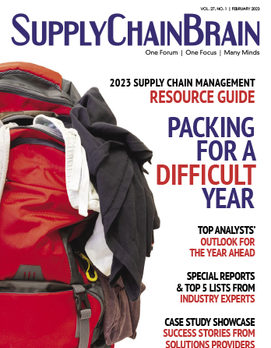
Think Tank
Solutions to the Supply Chain Bullwhip Effect

Photo: iStock.com/abrikaCr
One of the curses of the Great Supply Chain Disruption of 2020 was the phenomenon known as “the bullwhip effect.” It describes a series of events by which relatively small issues at the beginning of a supply chain become much larger and less controllable at the end of the “whip.”
U.S.-based retailer Target Corp. announced on June 7, 2022 that it was working through excess inventory due to unexpected changes in consumer behavior, and that it would take a short-term hit to its margin. Its merchandising teams had forecasted a continuation of high consumer demand for home goods.
The retailer now expects its Q2 operating margin rate to be 2% instead of its previous guidance of 5.3%, as it makes “revisions to sales forecasts, promotional plans and cost expectations by category,” according to a company statement.
As an example, take kitchen cookware. The category buyer normally might assume sales of 100 units per day, but the buying team is noticing sales that have reached 150 units per day. The retailer adjusts its forecast accordingly, and orders enough stock from the wholesaler to sell 200 units a day. The wholesaler receives the order for 200 items, then orders 300 units from the manufacturer. The manufacturer receives the order for 300 items and increases its manufacturing run to 400 items.
A spike in demand from 100 units a day has ballooned to 400 units, many of which won't reach the retailer until after the surge is over.
In the above example, the retailer didn’t anticipate the speed at which the consumer shifted spending to dining out, with less focus on home cooking and the need for new pans.
Manufacturing products takes time, so what happens if, while those items are being made, early demand fades for the retailer? Sales of cookware would immediately drop. The retailer's forecasts are then affected, and it won't order more units even though production has increased, leaving the manufacturer to seek alternative channels to reduce its inventory position, typically at deep discounts.
All of this amounts to periods of both overstock and low stock and unpredictability throughout the supply chain.
Causes of the Bullwhip Effect
The bullwhip effect starts with simple demand spikes, however many elements might contribute to it. Global supply chains are becoming more complex, consumer demands are changing, orders are more varied and detailed data is widely available. These and other factors can create a complex but competitive supply chain. Because these supply chains tend to involve more parties and touchpoints, there are many places for the bullwhip effect to take hold.
Secondly, meeting customer demands often involves more options, like in-store pickups and direct-from-vendor shipments. These differing requirements can increase pressure to have products on hand, and cause the supply chain to branch off into more avenues. Ensuring stock for each option can contribute to overstocking.
Moreover, partners in the supply chain might choose to round orders up or down for the sake of simplicity or wait until a certain date to order, which isn't necessarily an accurate reflection of demand. Discounts, sales and other offers affect typical demands and may also lead to inaccurate forecasts, as buyers attempt to reconcile these sales with their usual forecasting measures.
Ration gaming can also be a cause of the bullwhip effect. It occurs when upstream inventory becomes scarce, so retailers and suppliers order larger quantities and build up their own stocks to ensure they can meet demands, hurting the entire supply chain in the process. One study found that ration gaming increased the bullwhip effect by 6% to 19%. If replenishment product doesn't reach the seller for a long time, it won't line up with the demand and help the seller meet customer needs.
Impact on the Supply Chain
The impact of the bullwhip effect on supply chain management is significant. To start, trading partners have to pay for the physical storage space, as well as the inefficiency of storing items that might not be in high demand anymore, and the cost of transporting and selling the items, which could be steep if they have to discount the products to get people to buy them. None of this is cheap. The bullwhip effect also makes storage and shipping costs less predictable.
Trading partners will also need to pay employees to handle, sort and sell additional items on hand. Similarly, if a seller runs out of stock, salespeople might need to work harder to locate alternatives or arrange for deliveries later. These labor demands can add up.
Running out of a product can cause problems for a trading partner’s reputation and profits. The failure to supply a desired product can drive shoppers to look for new partners or brands.
Excessive inventory can also cause costly waste. Consumable goods, such as foodstuffs or pharmaceuticals, might expire before the stock is eliminated, while other items could be withdrawn from sale or replaced by newer versions. These events could reduce the items' value, increase the number of resources required to sell them, or cost the trading partner the price of an item that needs to be thrown away.
Countering the Bullwhip Effect
While the bullwhip effect can have a range of influences, it also has several solutions. Following are some tips on how to reduce it.
Increase transparency between suppliers and customers. The bullwhip effect amplifies because supply chain members don't have a full picture of why buyers are increasing demand. Improving visibility across the chain can help everyone see the context of demand changes.
Start predicting. Smart predictions are key to better understanding demand changes. Much of the industry is already getting on board; according to Gartner, over 50% of supply chain organizations will invest in artificial intelligence and advanced analytics applications by 2024.
Encourage collaboration between partners. Members of the supply chain need to work together to avoid feeling the bullwhip effect. Vendor-managed inventory is foundational for this approach, as it puts the necessary information for working together in one place, and uses electronic data interchange to both push and pull inventory and order data between partners.
Reduce lead times. Long lead times can exacerbate the bullwhip effect, with products arriving long after they're needed and becoming overstock. Reducing lead times across the board and placing orders when demand is high can mitigate bullwhip issues.
Minimize or address price fluctuations. Frequent promotions or discounts can disrupt typical buying patterns and make it tougher to predict demand. Trading partners should evaluate their stance on these promotions and see if they might be causing more interruptions than benefits. While it might not be necessary to get rid of them altogether, trading partners should consider minimizing them or incorporating them more accurately into their predictions and forecasts.
The bullwhip effect can quickly get out of control and hit every part of the supply chain with adverse effects. Visibility and transparency are some of the best resources for helping trading partners counter its effects. Organizations that can keep the bullwhip effect to a minimum can ensure more predictable and profitable supply chain management.
Peter Edlund is vice president of product management, retail at TrueCommerce.




